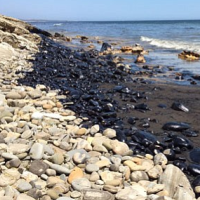Pipeline Company Says Its Estimate of Santa Barbara Oil Spill Was Way Low
 Refugio State Beach (photo: Paul Wellman, Santa Barbara Independent)
Refugio State Beach (photo: Paul Wellman, Santa Barbara Independent)
When breaking bad news to people, sometimes it’s a good idea to go slow and allow an opportunity for calm reflection and a measured response. So it is with oil companies and their oil spills.
Plains All American Pipeline (PAAP) has been slow to share information about its oil spill in May that gushed into the ocean just north of Santa Barbara, but revealed Wednesday in the company’s quarterly earnings update that it may have been 40% worse than advertised.
The Texas company revised upward its estimate that 101,000 gallons poured out of a corroded pipeline that burst to 142,800 gallons. Its earliest estimate was a far more rosier 21,000 gallons. The new figures are still preliminary. The company said it came up with the new number from an analysis of the badly corroded 10.6 miles of pipeline it removed.
“Unfortunately, this is what happens every time there’s an oil spill,” Linda Kropp, chief counsel of the Environmental Defense Center, told the Santa Barbara Independent. She highlighted the contradiction that makes it hard to include corporate polluters in the anti-pollution process:
“This is one of the reasons people are frustrated that Plains is part of Unified Command. It’s important to have them involved so they can be told what to do and provide access to equipment, but it’s important that they not come up with any assessments or plans for cleanup and restoration.”
Despite the misinformation, it is known to be the largest coastal California oil spill in a quarter century. Santa Barbara has been kinda touchy about oil spills since 1969, when a blowout at a Union Oil platform in the channel spewed between 80,000 and 100,000 barrels of crude oil into the ocean.
Senator Edward J. Markey (D-Massachusetts), a member of the Environment and Public Works and Commerce, Science and Transportation committees, took the occasion of the new estimate to point a finger at the federal Pipeline and Hazardous Materials Safety Administration for its propensity to withhold information and tolerate it in those it regulates.
Plains did not notify the feds for 90 minutes after discovering the spill, although the law requires them to do it right away. By then, folks had noticed the oil and the U.S. Coast Guard was leading a response.
Beachgoers are still dodging tarballs down in southern Los Angeles County, but the hundreds of sea birds and mammals that were coated in crude have either died or been cleaned up. Oil spread along the Gaviotta coast after the pipeline gave way and forced closure of Refugio and El Capitan state parks.
The spill occurred at the edge of a national marine sanctuary and state-designated underwater preserve that is full of whales, dolphins and sea lions, in addition to dozens of species of sea birds and more than 500 species of fish.
The Central Coast Regional Water Quality Control Board, which has the power to take administrative action against Plains, referred the Refugio spill (pdf) to the California Attorney General this week for judicial enforcement. The law allows the AG to seek monetary penalties of up to $25,000 a day per violation and $25 per gallon of oil spilled.
The pipeline is still out of commission.
–Ken Broder
To Learn More:
Refugio Oil Spill Likely Far Larger Than Projected (by Tyler Hayden, Santa Barbara Independent)
Santa Barbara Oil Spill May Have Been Far Larger Than Projected (by Michael R. Blood, Associated Press)
Refugio Oil Spill May Have Been Costlier, Bigger than Projected (by Joseph Serna, Los Angeles Times)
California Water Officials Seek Penalties in Santa Barbara Oil Spill (by Sharon Bernstein, Reuters)
Oil Spill from a Pipeline near Santa Barbara Coats the Shoreline (by Ken Broder, AllGov California)
- Top Stories
- Controversies
- Where is the Money Going?
- California and the Nation
- Appointments and Resignations
- Unusual News
- Latest News
- California Forbids U.S. Immigration Agents from Pretending to be Police
- California Lawmakers Urged to Strip “Self-Dealing” Tax Board of Its Duties
- Big Oil’s Grip on California
- Santa Cruz Police See Homeland Security Betrayal in Use of Gang Roundup as Cover for Immigration Raid
- Oil Companies Face Deadline to Stop Polluting California Groundwater




